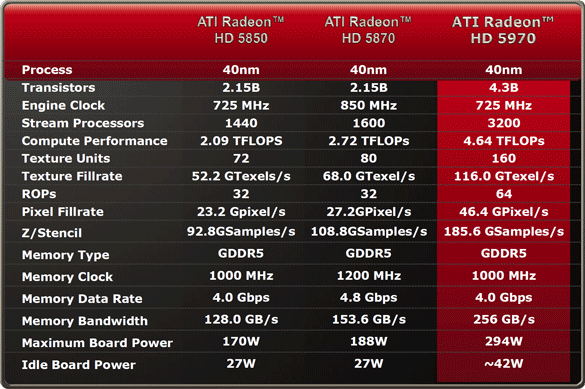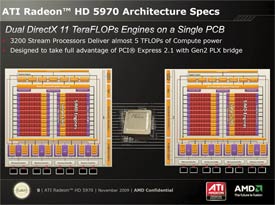ATI Radeon HD 5970 Dual-GPU Powerhouse Review
The ATI Radeon HD 5970

So, what differentiates the new Radeon HD 5970 from its Radeon HD 5800 series counterparts? Mainly it's the two Radeon HD 5800 series GPUs powering the card, but the comparison chart below does a good job of explaining what that means in terms of features and performance.

As you can see, the Radeon HD 5970 offers roughly double the performance of a Radeon HD 5850. What you'll notice, however, is that that 5970 is somewhat of a mix between the 5850 and 5870. All of the stream processors (1600) in each GPU are enabled in the Radeon HD 5970, hence it has double the total number of the Radeon HD 5870 (3200). The Radeon HD 5970's clock speeds, however, are in-line with the Radeon HD 5850. We're told it's the mixing of 5800 series specifications that resulted in the new naming convention for the Radeon HD 5970--it's not quite a 5850 X2 or a 5870 X2, so in an attempt to avoid confusion, AMD gave the card a name that should convey the message that the 5970 is the highest performer of the three.
With its GPUs, the Radeon HD 5970 offers roughly double the performance of a Radeon HD 5850, save for its peak fillrate which is somewhat higher. Max memory bandwidth from the card's 2GB of GDDR5 memory is 256GB/s, but keep in mind that's 128GB/s per GPU.
The 5970's maximum board power is rated for 294W, which somewhat explains why the 5970's clocks aren't higher. Had AMD pushed those stock frequencies any higher, max board power would be well north of 300 watts, which could post a problem to potential upgraders with power supplies that aren't up to snuff.


ATI Radeon HD 5970 Architectural Details
The Radeon HD 5970 architecture is much like previous X2 cards. Each of the card's GPUs are linked together on a single PCB, via a PLX PCI Express 2.1 Gen 2 bridge. The setup is essentially "CrossFire on a card". The dual-GPU configuration gives the Radeon HD 5970 peak compute performance of over 4.6 TeraFLOPs with 116GTexels/s of texture fillrate.
More when into the design of the Radeon HD 5970 than slapping a pair of GPUs on a single PCB. To ensure significant overclocking headroom, AMD used 5.0 Gpbs (1250MHz) GDDR5 memory on the 5970, despite the 1000MHz default clock. In addition, the cards feature digital programmable Volterra Regulators, pure ceramic Japanese caps, and real-time power monitoring circuitry. The GPUs on the Radeon HD 5970 are also screen high-speed / low-leakage ASICs, and the cooling solution is capable of handling far more heat than is put off in the stock configuration.
AMD ATI Radeon HD 5970 Reference Card
The Radeon HD 5970 card itself is 12" long and features a black fan shroud that encases the entire PCB, that looks similar to the 5870. 12" is HUGE for a graphics card, so take note of its size. We had to remove the hard drive cage in our test machine to accommodate this beast. The card's cooler has a barrel fan that draws air into the shroud, where it is forced through the heatsink and partially exhausted from the system through vents in the card's mounting plate. Two more small vent at the back of the card also direct some air to be vented within the system. Overall, the cooling solution is much like the one used on the Radeon HD 5870, but it features a single, large vapor chamber and is capable of dissipating up to 400 watts.
AMD ATI Radeon HD 5970 Reference Card
The Radeon HD 5970 sports a GPU clock of 725MHz with a memory clock speed of 1 GHz (4Gbps effective). According to AMD, maximum board power is 294 Watts, up slightly from the previous generation dual-GPU powered 4870 X2, but idle board power is only 42 Watts. The low idle power comes by way of aggressive clock gating and voltage reductions when the card is not under a significant workload. Due to the relatively high peak power though, 6-pin and 8-pin supplemental power connectors are required.
The outputs on the Radeon HD 5970 consist of dual, dual-link DVI outputs and a DisplayPort output. With this output configuration, connecting the card to an HDMI input requires the use of a DVI-to-HDMI dongle, and three screen Eyefinity configurations are possible. We should also note, that beginning with the 5970, Eyefinity will support multi-GPU scaling with certain game titles. Once the kinks are worked out, AMD plans to migrate Eyefinity support to 5800 series CrossFire configurations as well.








